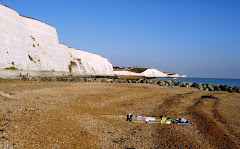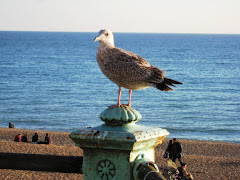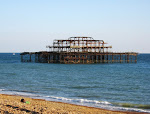 The other weekend I did a wonderful walk starting out from Devil's Dyke, situated on the South Downs, north of Brighton.
The other weekend I did a wonderful walk starting out from Devil's Dyke, situated on the South Downs, north of Brighton.Although this time I walked down and away from the Dyke, it makes for a great afternoon out in its own right: superb views, good walks, and (the least good bit) a pub. It’s a great place to fly a kite as it’s almost always windy (though sometimes too windy for flimsy modern kites…), although you’ll be competing for air-space with hang-gliders and micro-light aircraft. The whole hilltop is classified as an Area of Outstanding Natural Beauty.
The Dyke itself is a natural geological feature, formed by melt water at the end of the last Ice Age: it’s a short, very steeply sided V-shaped valley, which cuts into the north face of the South Downs, above the village of Poynings. The Dyke is only 1km long and narrows from 400m to a blind point, but is over 200m deep, making it the deepest true dry valley in Britain (ie, with no waterway) and, some say, in the world.
The name comes from a wonderful (and more entertaining) legend. Apparently furious at the conversion of the peoples of the Weald to Christianity, the Devil decided to dig a dyke through the South Downs, so the sea could flow in and drown their villages. To ensure his efforts were not discovered until it was too late, he decided to dig it over a single night. However, his toils woke an old woman, who lit a candle: this then woke her cockerel, who began to crow. Seeing the light and hearing the cockerel, the Devil was fooled into thinking it was dawn, and rushed off with his work uncompleted, and the Weald was saved.
The adjacent hilltop was first settled by Iron Age fort builders, who found the natural spur formed by the Dyke to be a superb defensive site. The remains of their earth ramparts can still be traced, albeit with some difficulty. But the beauty of the place gradually attracted more visitors, and in 1887 a railway was built from Brighton to bring visitors up to the Dyke. This proved a runaway success – an astounding 30,000 of them visited the Dyke on Whit Monday in 1893, and over a million during 1897.
By the turn of the 19th century, the Dyke had a hotel, a 360m aerial cable-car across the Dyke, and a two-tracked funicular railway 250m down to Poynings. Alas, the short season and high costs forced the closure of these attractions by 1910, although the railway from Brighton survived until 1938. The faint remains of the cable-car and funicular can also be found at the site if you look closely. The hotel survived, later to be replaced by a refreshment room, the predecessor of to-day’s pub.
You can get there by road (it's well signposted off the A27) or by an open-topped bus service from Brighton (daily in the summer), or for the more energetic, via the South Downs Way.



1 comment:
Many, many happy memories. Unsuccessful kite-flying, more successful sexual fumblings in my late teens. Picnics with parents and great views followed by trips to the surrounding villages and towns to the north.
Post a Comment